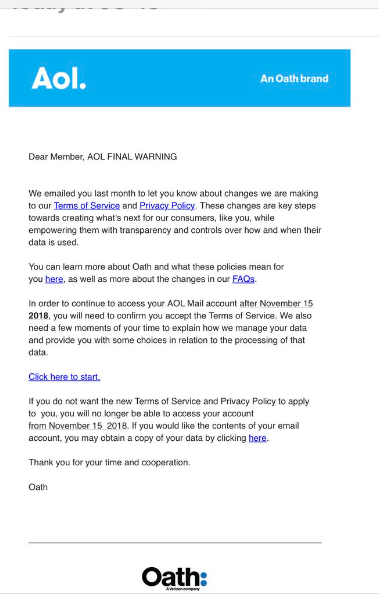What is AOL Email Scam
AOL Email Scam refers to a spam email campaign that tries to phish AOL login credentials. The phishing email is disguised to look like it’s sent by AOL though the company is in no way associated with this scam. If you’re not familiar with phishing, it’s a type of attack that tries to trick users into typing in their login credentials into malicious websites. If users type their login details, the cybercriminals operating the phishing campaign immediately get the credentials and can use them to access accounts. Phishing campaigns like the AOL Email Scam are particularly dangerous because email accounts hold quite a lot of important information, and if malicious actors manage to get it, they can do a lot of damage.
The AOL Email Scam email claims that you recently requested to close your email account. The email is supposedly a chance for you to cancel the closure if you wish. The scammers expect that when a user is informed about their account’s closure, they will immediately react because of the urgency. If you were to click on the “Cancel De-activation” button in the email, you would be taken to a fake AOL Mail website and asked to log in. Only instead of logging into your actual AOL account, you would be giving away your login credentials to malicious actors.
How to recognize a phishing email
In many cases, phishing emails are quite generic, which means they are not difficult to recognize as long as you pay attention. The biggest sign that you could be dealing with a phishing email or one that could be malicious is grammar/spelling mistakes. The AOL Email Scam does not look even remotely legitimate because it has grammar mistakes in it. No email from AOL, especially an automatically generated one, will have grammar mistakes in it because they look unprofessional. As long as you carefully read your emails, you should be able to spot potentially malicious ones.
AOL Mail is focused on keeping you safe while you use the best mail product on the web. One way we do this is by protecting against phishing and scam emails though the use of AOL Official Mail.
When we send you important emails, we’ll mark the message with a small blue AOL icon between the sender and subject of the email. Additionally, when you open the message, you’ll see the “Official Mail” banner above the details of the message.
Additionally, when you open the message, you’ll see the “Official Mail” banner above the details of the message.
 If you get a message that seems like it’s from AOL, but it doesn’t have those 2 indicators, it’s a fake email. Make sure you immediately mark it as spam and don’t click on any links in the email.
If you get a message that seems like it’s from AOL, but it doesn’t have those 2 indicators, it’s a fake email. Make sure you immediately mark it as spam and don’t click on any links in the email.
A completely different matter is when malicious actors have access to some personal information. At the bare minimum, knowing a victim’s full name can quite significantly increase the chances of them falling for a phishing email. But even if cybercriminals have some of your personal information, you can still recognize phishing emails.
One of the first things you should check when you receive an email that asks you to click on a link is the sender’s email address. If the phishing attempt is more sophisticated, the email address will look more legitimate instead of being completely random. But even then, a search with Google or another search engine will make clear whether the sender’s email address actually belongs to the company the sender claims to be from.
Perhaps the most obvious and the easiest thing to check is the site’s URL. You can do that even before clicking on the link. Simply hover over the link with your mouse, and the address will appear near the bottom. If the address does not look right, do not click on the link. Even if the address looks correct, you should be careful. When on a site that asks you to log in, always check the URL. Scammers can imitate a site’s design quite well and make it look more or less identical but the URL will always be different. So before you log in anywhere, always check the URL.
Delete AOL Email Scam
If this email landed in your inbox, you can simply delete AOL Email Scam. If you did not interact with it, you don’t need to do anything. Simply clicking on the link also likely didn’t do anything malicious. However, if you entered your AOL login credentials, you need to change your password immediately if you can still access your account. And if you have not done so already, you need to enable two-factor authentication (2FA). There are different 2FA methods, but while it may be better than nothing, it’s not recommended to use SMS 2FA because it’s not difficult to intercept it.
If you have lost access to your email account, you can try contacting AOL to try and get it back.

I think I got this scam e-mail. Thankfully I double checked before I proceeded to update information.